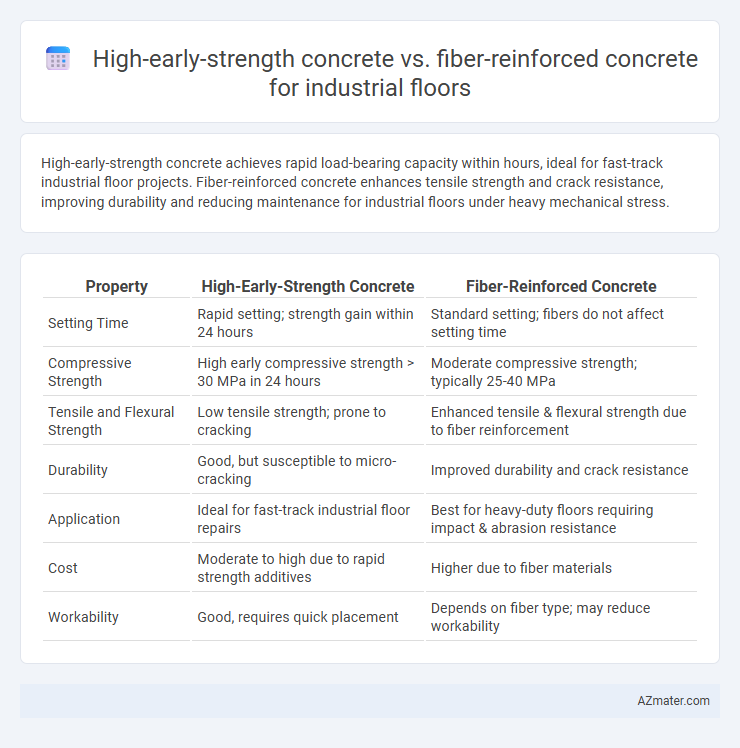High-early-strength concrete achieves rapid load-bearing capacity within hours, ideal for fast-track industrial floor projects. Fiber-reinforced concrete enhances tensile strength and crack resistance, improving durability and reducing maintenance for industrial floors under heavy mechanical stress.
Table of Comparison
| Property | High-Early-Strength Concrete | Fiber-Reinforced Concrete |
|---|---|---|
| Setting Time | Rapid setting; strength gain within 24 hours | Standard setting; fibers do not affect setting time |
| Compressive Strength | High early compressive strength > 30 MPa in 24 hours | Moderate compressive strength; typically 25-40 MPa |
| Tensile and Flexural Strength | Low tensile strength; prone to cracking | Enhanced tensile & flexural strength due to fiber reinforcement |
| Durability | Good, but susceptible to micro-cracking | Improved durability and crack resistance |
| Application | Ideal for fast-track industrial floor repairs | Best for heavy-duty floors requiring impact & abrasion resistance |
| Cost | Moderate to high due to rapid strength additives | Higher due to fiber materials |
| Workability | Good, requires quick placement | Depends on fiber type; may reduce workability |
Introduction to Industrial Flooring Requirements
Industrial flooring demands exceptional durability, load-bearing capacity, and rapid setting to minimize downtime, making high-early-strength concrete ideal for fast-track projects requiring early load application. Fiber-reinforced concrete enhances toughness, crack resistance, and impact durability, crucial for heavy machinery and dynamic loads in industrial environments. Selecting the appropriate concrete type depends on balancing early strength development with long-term performance and wear resistance specific to industrial floor needs.
Overview of High-Early-Strength Concrete
High-early-strength concrete achieves rapid strength gain typically reaching 5,000 psi within 24 hours, making it ideal for industrial floors requiring quick turnaround times. Its accelerated curing process reduces construction downtime and enhances early load-bearing capacity, supporting heavy machinery and traffic soon after placement. Compared to fiber-reinforced concrete, it emphasizes speed of strength development over crack resistance and durability.
Fundamentals of Fiber-Reinforced Concrete
Fiber-reinforced concrete (FRC) enhances industrial floor performance by integrating discrete fibers such as steel, glass, or synthetic materials, which improve tensile strength, crack resistance, and durability compared to high-early-strength concrete (HESC). The fibers bridge micro-cracks and distribute stress more evenly, reducing shrinkage and impact damage, leading to extended service life in heavy-duty applications. Unlike HESC, which gains compressive strength rapidly but lacks enhanced toughness, FRC provides superior structural integrity and resilience under repetitive loading.
Key Performance Criteria for Industrial Floors
High-early-strength concrete achieves rapid load-bearing capacity, minimizing downtime and enabling faster project completion, while fiber-reinforced concrete enhances crack resistance, durability, and impact toughness under heavy industrial loads. For industrial floors, critical performance criteria include compressive strength, abrasion resistance, flexural strength, and resistance to chemical spills; high-early-strength concrete excels in early strength gain but fiber-reinforced concrete offers superior long-term crack control and toughness. Optimal industrial flooring often integrates fiber reinforcement within high-early-strength mixtures to balance accelerated strength development with enhanced structural resilience.
Speed of Construction and Early Loading Capabilities
High-early-strength concrete provides rapid strength gain, allowing industrial floors to support heavy loads within 24 hours, significantly accelerating construction schedules. Fiber-reinforced concrete enhances crack resistance and long-term durability but typically gains strength at a standard rate, which may delay early loading. For projects prioritizing speed and early loading, high-early-strength concrete offers a more efficient solution, while fiber reinforcement is better suited for durability and crack control once the floor is operational.
Durability and Crack Resistance Comparison
High-early-strength concrete offers rapid load-bearing capacity, making it suitable for fast-track industrial floor projects, but it may exhibit higher shrinkage and reduced long-term crack resistance compared to fiber-reinforced concrete. Fiber-reinforced concrete incorporates synthetic or steel fibers that enhance tensile strength, improve crack control, and significantly increase durability under heavy industrial traffic and thermal cycling. The integration of fibers reduces micro-cracking and prolongs service life, resulting in superior performance for industrial floors subjected to dynamic loads and harsh environments.
Load-Bearing Capacity Analysis
High-early-strength concrete offers rapid strength gain, achieving compressive strengths of up to 40 MPa within 24 hours, making it ideal for fast-track industrial floor projects needing quick load-bearing capacity. Fiber-reinforced concrete enhances tensile strength and crack resistance by integrating steel or synthetic fibers, improving durability and load distribution under dynamic industrial loads. Load-bearing capacity analysis shows that while high-early-strength concrete provides immediate high compressive strength, fiber-reinforced concrete delivers superior toughness and post-crack load capacity, crucial for floors subjected to heavy machinery and impact forces.
Maintenance and Lifecycle Costs
High-early-strength concrete significantly reduces downtime during construction of industrial floors, enabling faster operational turnover and reducing initial labor costs. Fiber-reinforced concrete enhances crack resistance and durability, lowering maintenance frequency and extending the lifecycle of the floor. Over time, fiber-reinforced concrete often results in lower total maintenance and repair expenses compared to high-early-strength concrete, especially in environments with heavy machinery and dynamic loads.
Sustainability and Environmental Impact
High-early-strength concrete offers rapid load-bearing capacity, reducing construction time and minimizing site emissions, while fiber-reinforced concrete enhances durability and crack resistance, extending the floor's lifespan and reducing repair-related waste. The sustainable benefits of fiber-reinforced concrete include improved toughness that lowers the frequency of replacements, thereby conserving raw materials and energy over time. High-early-strength mixtures may require higher cement content, increasing carbon footprint, whereas integrating fibers, especially recycled or natural ones, can reduce the environmental impact of industrial floor systems.
Choosing the Optimal Concrete Solution for Industrial Floors
High-early-strength concrete offers rapid curing and early load-bearing capacity, making it ideal for projects demanding quick turnaround times and minimized downtime. Fiber-reinforced concrete enhances tensile strength, crack resistance, and durability, ensuring long-term performance under heavy industrial traffic and mechanical stresses. Selecting the optimal solution depends on project timelines, load requirements, and exposure conditions, balancing early strength gains with enhanced durability for industrial floor longevity.

Infographic: High-early-strength concrete vs Fiber-reinforced concrete for Industrial floor
 azmater.com
azmater.com